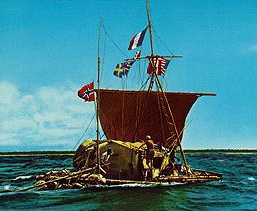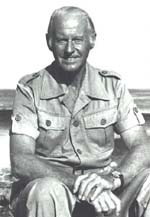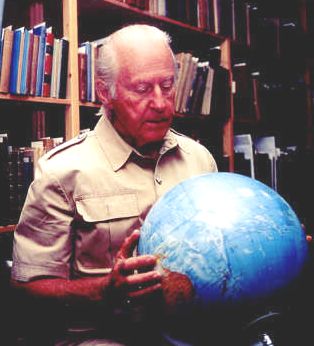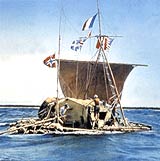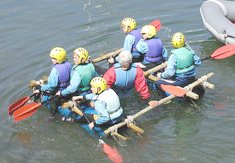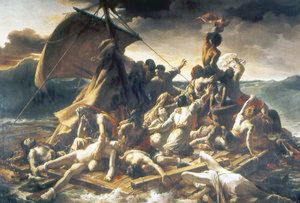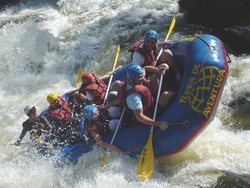|
THOR HEYERDAHL and the KON TIKI EXPEDITION
|
|
|
During 1937 - 1938 Thor Heyerdahl received a zoological grant to research animal life on the Marquesas Islands. His interest soon turned as to how these Islands and Polynesia in general, had become populated.
Heyerdahl observed that wind and ocean streams flowed from across the Pacific from east to west. Since there were cultural similarities to be found on either side of this ocean, he formed the theory that the Polynesian Islands had been populated from South America. This generated a storm of protest from scientists, since it was widely accepted that the islands had been populated from the east, from Indonesia.
Kon Tiki raft
The main argument against Heyerdahl's theory was the lack of evidence of Pre-Colombian Indians in South America having had sea-going vessels capable of crossing the expanse of ocean between South America and Polynesia.
Thor Heyerdahl was so convinced that the Polynesian Islands were settled by people from Peru, South America, that he needed to prove his theory. He organized an expedition of six men, built a primitive raft of balsa wood and bamboo that had a small shelter, named it Kontiki and on April 28, 1947, left Peru on a voyage full of adventure, hoping the prevailing wind and ocean current would bring them to Polynesia.
To prove his theory, Heyerdahl decided to build a replica of the Indian balsa wood rafts. In 1947 he set off on the 1st KonTiki expedition, finally making a landfall just as the raft was sinking - it had become waterlogged. He thus successfully proved that Indian balsa wood rafts were able to cross the Pacific Ocean. Later in 1961 another raft was constructed and the KonTiki legend continued for others to enjoin.
Tuna, bonito, shark and dolphins were in abundance and provided their steady diet. Sailing 50 to 60 miles a day in the Humboldt Current and prevailing easterly wind, the raft could only go forward, towards Polynesia. A heavy storm sent 15-foot waves over their raft, severely damaging the cabin and the large steering oar. A cry of "man overboard" had all hands struggling to rescue radio operator Forstein, who narrowly escaped death.
Thor Heyerdahl
From the very start the Kontiki expedition was bound to be fraught with problems. As with Solarnavigator, there was only one way to say for sure what might be possible. Thor Heyerdahl is the kind of practical scientist much admired by the Elizabeth Swann team. He was prepared to back his theory and as such is an inspiration to us all.
Thor Heyerdahl was a multimedia mogul before the term "multimedia" existed.. Part scientist, part adventurer and part showman, the Norwegian explorer has dedicated a long life to oceangoing voyages that attempted to show (if not prove) that ancient mariners could cross oceans in vessels that "experts" swore would sink just across the horizon.
Books by this larger-than-life character fired my father's imagination and stayed with me. Through the various documentaries, should you be so lucky to view them, you can see what actually transpired on those long voyages on the Kon-Tiki from Peru to Polynesia in 1947, or from Africa to the West Indies aboard the papyrus vessel Ra in 1970.
HEYERDAHL'S VOYAGES
1.Tigris voyages: seagoing journeys to Mesopotamia, Egypt and the Indus Valley, to show that the ancient world's first three great civilizations could cross-pollenate ideas, goods and people.
2. Ra I and Ra II, transatlantic trips (well, nearly transatlantic for Ra I, which fell a bit short) to show ancient Egyptians could have visited the Caribbean on ships constructed from gargantuan bundles of floating reeds.
3. Kon-Tiki, the legendary journey from Peru to Polynesia on a balsa raft -- the journey that made Heyerdahl famous in 1947.
4. The Easter Island expedition, which attempted to answer the question: "Why, if ancient Peruvians could travel through the Pacific to Polynesia, didn't they stop off at the Easter Islands, a relatively short journey off the coast of South America?" Heyerdahl's answer: They did, as shown by artifacts he unearthed in archaeological expeditions there.
This is the stuff of adventure: iconoclastic ideas proven to an scoffing scientific establishment by manly men setting out on, if not a wing and a prayer, then a flimsy balsa raft and a boatload of courage.
BIOGRAPHY
Sr. Kon-Tiki passed away quietly in his home in Italy the 18 of April 2002, at an age of 87. As one of the most famous Norwegians ever, he has accomplished many different things in his life, but his name will always be intimately tied to the Kon-Tiki voyage and the archaeological investigations on Easter Island (Rapa Nui) and East Polynesia.
He was born in the small town of Larvik on the 6th of October 1914. As a young boy he was interested in zoology and biology and had a dream to become an explorer and travel to exotic countries far away. After university studies in biology and geography at Oslo University as well as studies of anthropology in Bjarne Kroepelien’s famous Polynesia library in 1933-36, he and his first wife, set out to live on Fatu Hiva in the Marquesas archipelago in 1937-38. This journey had a great influence on his life. Before reaching the Marquesas he was "adopted" by Chief Teriiro’o on Tahiti, who appropriately gave Thor the name Te Rai ma te ata (Reflection of the Sky). On Fatu Hiva the young couple lived like Polynesians and experienced both good and bad days. However, the important experience for Thor was that he saw that plant life, the winds and currents as well as traditional history could point to that the ancestors or forerunners of the Polynesians could have come from the East – South America.
Later he developed this theory in his book "American Indians in the Pacific". However, the scientific community did not accept his ideas and this is the reason why he decided to prove this theory in real life. On the 28th of April 1947 he, and his five crewmembers, set out from Callao in Peru on the Kon-Tiki balsa raft built in a traditional style. They drifted 4300 miles during 101 days and ended up on Raroia in the Tuamotus archipelago. The voyage was a success and Heyerdahls book about the voyage became a bestseller and translated to at least 70 languages it has sold in millions of copies all around the world. Heyerdahls film about the Kon-Tiki voyage was awarded an Oscar for best documentary in 1951.
Thor Heyerdahl has always been dedicated attempting to prove his theories on contacts of prehistoric societies with the aid of traditional boats types. In 1969 he built the reed ship RA after models of traditional boat types in Egypt. He and his international crew crossed the Atlantic Ocean in this vessel, but due to a mal-construction it dissolved just before reaching the Caribbean. Then - he set his mind to make another try. With RA II he set out from Safi in Marocco in 1970 and came ashore on Barbados 57 days later. In 1977 - Heyerdahl constructed still another reed ship. It was built in Iraq and named Tigris. He sailed with an international crew during 5 months in the Persian and Arabian Sea with the goal to end up in Egypt to prove that the great ancient civilizations in Mesopotamia, Indus Valley and Egypt had contact by sea. Actions of war in the area stopped the voyage and in protest Heyerdahl burnt his ship.
In addition to his maritime interests he has also sponsored archaeological research. With his investigations on The Galapagos in 1952-53 and Easter Island in 1955-56 and 1986-88, he and his archaeologists are pioneers in Pacific archaeology. In addition to the research in the Pacific region he has carried out research on The Maldives in 1983-84, Tucume Peru in 1989-94, Tenerife in 1991,1999, 2000 and Azov in Russia during 2001. In addition he has sponsored research on pre-historic monuments on Sardinia and Sicily. Even during his last days he had far-reaching plans of an archaeological expedition to Samoa to excavate the largest ceremonial monument in the Pacific, Pulemelei on Savai’i.
With several honorary doctorates and other awards as well as an extensive production of books, articles and films in addition to his many expeditions and travels he has lived a very productive and full life. With his artistic and intellectual abilities he has for example created classical books as "The Kon-Tiki expedition" and "Aku-Aku, The Secrets of Easter Island", enjoyed by millions of readers all around the world. Furthermore, his scientific papers and books have inspired a whole generation of scientists dealing with the prehistory of the Pacific.
Heyerdahl lived his last years on Tenerife, Canary Island, where he took part in creating a Museum and center for research. The famous Kon-Tiki raft as well as RA II is housed at the Kon-Tiki Museum in Oslo. Tied to the Museum is an Institute for Pacific Archaeology and Cultural History.
Thor Heyerdahl was an extraordinary and complex person in many ways, both controversial and humble at the same time. He cared very much for the environment and reflected over the "big issues" in life as well as battling fiercely for his theories on diffusion and maritime contacts between the great civilizations of the past.
Now, when he has set out on his final journey he will be greatly missed, not just by family and friends but also by his many readers and admirers as well as different scientists, some whom he worked with and some whom he battled against. In his later years he continued to work actively, amongst others with Donald Ryan. He also was a board member of the Green Cross international.
Thor
Heyerdahl -
Genialer Naturforscher oder Enfant
Terrible der Wissenschaft? Als
Thor Heyerdahl am 28. April 1947 mit seinem
selbstgebauten Balsaholz-Floß "Kon-Tiki" von
Peru aus in die Südsee aufbricht, gilt er in der
wissenschaftlichen Fachwelt als Spinner. Niemand kann
sich vorstellen, dass die Expedition mit diesem
primitiven Gefährt tatsächlich ihr Ziel erreicht und
auf den rund 7.000 Kilometer entfernten pazifischen
Inseln ankommt.
Mit einem Floß über den Pazifik - Kon-Tiki
Heyerdahl jedoch ist überzeugt von der Besiedlung Polynesiens aus Südamerika und beschließt die Sache selber in die Hand zu nehmen. Nach Vorgaben uralter Überlieferungen lässt er im peruanischen Hafen Callao ein Floß bauen, das den Namen Kon-Tiki tragen soll. Er achtet darauf, dass vor allem junge Stämme verwendet werden, denn die werden nicht so schnell vom Meerwasser durchtränkt.
Noch im Jahr 1947 ist das primitive Vehikel fertig und Heyerdahl sticht am 28. April mit fünf Begleitern - samt und sonders ohne größere seemännische Erfahrung - in See. Mit Unterstützung des Humboldt-Stroms und der vorherrschenden östlichen Winde will er die rund 7.000 Kilometer lange Reise zu den Inseln Polynesiens bewältigen. An Bord stapeln sich die Vorräte. Auch viele wissenschaftliche Instrumente und vor allem genügend Trinkwasser gehen mit auf die Reise ins Ungewisse.
Die
Crew lässt sich bei ihrem Vorhaben auch von den
Kassandra-Rufen der Behörden und der Marine vor Ort
nicht entmutigen, die ein baldiges Scheitern der
Expedition und den Tod aller Crew-Mitglieder vorhersagen.
Und siehe da, das Floß erweist sich von Anfang an als
viel hochseetauglicher als man selbst erhofft hatte. Bis
aber die Mannschaft alle Tricks und Kniffs beherrscht,
um das Floß sicher zu manövrieren, vergeht einige Zeit.
Immer wieder gerät die Kon-Tiki dadurch in brenzlige
Situationen, die sie nur mit viel Glück heil übersteht.
Ein Verbindung zur Außenwelt besteht nur über das
mitgenommene Funkgerät.
Land in Sicht - nach etwas mehr als drei Monaten gibt es
für die Kon-Tiki und ihre Besatzung schließlich Grund
zum Feiern. Die Atolle des Tuamotu-Archipels sind es,
die da am Horizont auftauchen und zum Symbol für den
Triumph Heyerdahls werden: Die polynesische Inselwelt
ist erreicht. Der Abenteurer hat der Welt und vielen
argwöhnischen Zeitgenossen bewiesen, dass die Einwohner
Südamerikas tatsächlich schon vor tausenden von Jahren
die Mittel besaßen, um über den Pazifik bis nach
Polynesien zu gelangen. Und auch die Besiedlung
Polynesiens von Südamerika aus ist zwar damit nicht
bewiesen, zumindest aber in den Bereich des Möglichen
gelangt. Müssen die Geschichtsbücher schon bald neu
geschrieben werden?
Nun, die Besatzung der Kon-Tiki hat bei aller Euphorie
über das erreichte Ziel, erst einmal andere Probleme zu
lösen. Gefährliche Riffe behindern das Anlanden.
Schließlich strandet die Kon-Tiki auf einem der gefährlichen
Korallen-Bauwerke des Raroia-Atolls und die Besatzung
hat alle Hände voll zu tun, um sich auf einer nahen
Insel in Sicherheit zu bringen. Als sie endlich sicheren
Boden unter den Füßen haben, ist Zeit eine aus Südamerika
mit gebrachte Kokospalme als Zeichen ihres Erfolgs
einzupflanzen.
Ein französisches Schiff befreit die Crew der Kon-Tiki
schließlich aus ihrem "Robinson-Dasein". Es
nimmt sie und ihr Floß an Bord und bringt sie nach
Tahiti - die von Heyerdahl so ungeliebte Zivilisation
hat die Expeditionsmitglieder wieder eingeholt. Viel
Zeit zum Nachdenken bleibt allerdings nicht.
Ausgerechnet ein norwegischer Ozeanriese liegt dort
gerade vor Anker und bringt den Landsmann und seine
Kollegen auf direktem Weg in die USA.
Dort werden sie von der Weltpresse und der
amerikanischen Öffentlichkeit begeistert empfangen. In
Windeseile erlangen die erfolgreichen Abenteurer
Kultstatus und weltweite Berühmtheit. Aus dem
angeblichen Phantasten ist im Handumdrehen die Koryphäe
unter den Entdeckern des 20. Jahrhunderts geworden.
The program is similar to a PC game, and lets you move around freely and explore part of the museum as a 3D-model. To see the rest of the museum, come visit the real one in Oslo!
Instructions:
1. Right click here and select "save target as" to download the installer. (8MB download) 2. Run the installer you downloaded ("VR Kon-Tiki.msi") 3. Start VR Kon-Tiki from the "Start" menu or the new shortcut on your desktop, and follow the on-screen instructions
WHAT IS A RAFT
A raft is a special type of boat, distinguished by the absence of a hull. Rafts are kept afloat either by buoyant materials such as wood, or by inflated containers.
This technology has been superseded by hulled boats in most parts of the world but inflatable rafts manufactured of flexible materials are used for recreational navigation of whitewater.
Rafting is a recreational activity utilizing a raft to navigate a river or other body of water. Whitewater rafting can be a dangerous activity if the proper precautions are not taken. Below is a generally accepted classification system used to classify rivers for rafting and boating difficulty:
Class I - Easy. Fast moving water with riffles and small waves. Class II – Novice. Straightforward rapids with wide, clear channels. Class III - Intermediate. Strong eddies and current, requiring skilled maneuvering. Class IV - Advanced. Powerful but predictable rapids requiring precise boat handling in turbulent water. Class V - Expert. Long, obstructed, or violent rapids which expose paddlers to a high degree of danger, requiring expertise and reliable equipment for safe passage. Class VI - Unrunnable. Likelihood of death, or destruction of equipment in attempting class 6 runs.
As expertise increases, and equipment becomes more durable, or reliable, what was once considered class 6 becomes class "5 plus", and eventually class five. The Grand Canyon has swallowed whole expeditions, leaving only fragments of boats, yet it is now run by commercial outfitters hundreds of times each year, with relatively untrained passengers.
THE RAFT OF THE MEDUSA
The Raft of the Medusa is the name applied to an infamous catastrophic shipwreck of the French ship Medusa in 1816 in the Atlantic Ocean off the west coast of Africa. The incident, which led to the demise of 140 crew and passengers, was popularized throughout Europe by account of survivors, leading to a scandal in the French government because of the incompetence of the ship's captain and the feeble rescue effort. It was later the subject of several notable paintings, the most famous one of which is by Théodore Géricault and hangs in the Louvre.
History
In 1816 the new Bourbon government of France sent a small fleet to officially receive the British handover of the port of Saint-Louis in Senegal to France. The fleet consisted of four ships; the Loire, the brig Argus, the Echo and the Medusa. Medusa was to carry the passengers, including the appointed French governor of Senegal, Colonel Julien-Désire Schmaltz and his wife Reine Schmaltz. In addition there were a total of 400 passengers, including 160 of the crew.
The French Ministry of the Marine made the mistake of appointing inexperienced Frigate-Captain Hugues Duroy de Chaumereys to lead the fleet. He had mainly worked as a customs officer more than twenty years previously and had worked against Napoleon. His crew did not particularly appreciate him, because they had served with Napoleon during his reign.
The fleet left Port de Rochefort on June 17. Medusa sailed quickly away before the rest of the fleet. On July 17, it ran aground in shallow water off the west coast of Africa on the Arguin Bank.
At first the crew tried to release her by throwing heavy items overboard, but de Chaumereys stopped the effort. Eventually he decided to abandon ship. Because there were only six lifeboats, he made a raft out of masts and crossbeams to carry the rest of the crew. Dignitaries – 250 of them – took the lifeboats and attempted to tow the raft. The raft was too flimsy to keep all the rest (149 men and one woman) afloat. Seventeen men decided to stay on Medusa. The rest were left with no food and water to speak of.
Those in lifeboats soon noticed that the idea of towing the raft was impractical. De Chaumereys decided to cut the rope and leave the rest of the crew to its fate, four miles (6 km) off shore. (Not correct: it was Governor Schmaltz's raft that was first to drop the tow line to the raft.)
On the raft, the situation deteriorated rapidly. Men began to throw wine and flour out of spite and fight among themselves. On the first night 20 men – whites and Africans, soldiers and officers – were killed or committed suicide. Rations dwindled ever more rapidly and on the fourth day some on the raft resorted to cannibalism. On the eighth day, the fittest began throwing the weak and wounded overboard.
Thirteen days later, when Argus found the raft almost by accident, there were only 15 survivors remaining. Argus took them to Saint-Louis to recover. Five of the survivors, including Jean Charles, the last African crew member, died within days. Three of the seventeen men that had decided to stay on the Medusa were later recovered alive. British naval officers helped the survivors to return to France because aid from the French Minister of the Marine was not forthcoming.
The raft of the Medusa by Theodore Gericault
Medusas surviving surgeon Henri Savigny submitted his account to the authorities. It was leaked to an anti-Bourbon newspaper, the Journal des debats, and appeared on September 13, 1816. The matter became a scandal embroiled in French internal politics and officials tried to cover it up. De Chaumereys was found guilty in the court martial at Port de Rochefort.
Savigny and ship's geographer Alexander Corréard released their own account (Naufrage de la frégate la Méduse) of the incident in 1817. It went through five editions by 1821 and was also published in an English translation.
Géricault's depiction
Impressed by accounts of the shipwreck, the 25-year-old artist Théodore Géricault decided to make a painting based of the incident and contacted the writers in 1818. In order to make the painting as realistic as possible, Géricault made sketches of bodies in the morgue of the Hospital Beaujon. His finished painting, however, toned down the horror of the event by depicting the raft at the moment of rescue, with the Argus on the horizon.
Géricault used friends as models, notably the painter Eugène Delacroix as the figure in the foreground with his face to the ground and arms outstretched. The painting, which was on the epic scale of a history painting yet based on a current news story, first appeared in the Paris Salon in 1819 and was a sensation. It currently resides in the Louvre.
Portrayals in film
Iradj Azimi. Le Radeau de la Méduse, French film, 1998
Cast: Jean Yanne (Chaumareys), Philippe Laudenbach (Julien Schmaltz), Claude Jade (Reine Schmaltz), Laurent Terzieff (Théodore Géricault), Daniel Mesguich (Lt. Coudein), Alain Macé (Henri Savigny), Jean Desailly (La Tullaye), Rufus (Soldier musician).
Portrayals in literature
A History of the World in 10½ Chapters by Julian Barnes — a semi-fictional work that attempts to deglaze and satirise popular historical legends. The chapter Shipwreck is devoted to the analysis of this painting. The first half narrates the incidents leading to the shipwreck and the survival of the crew members. The second half of the chapter renders a dark platonic and satirical analysis of the painting itself, and Gericault's "softening" the impact of crude reality in order to preserve the aestheticism of the work.
The untranslated second volume of Peter Weiss's novel The Aesthetics of Resistance (Die Ästhetik des Widerstands) opens with a detailed historical account of the Medusa and subsequently describes Géricault's painting.
Other portrayals in popular culture
The second album by Irish folk-rock group The Pogues, Rum, Sodomy, and the Lash, uses the famous painting as its album cover, with the faces of the band members replacing those of the men on the raft. Also, on their album Hell's Ditch they pay tribute to the incident with the song "The Wake of the Medusa".
The layout of the scene is copied in the French comic book Astérix Légionnaire (Goscinny/Uderzo, 1967) to depict yet another shipwreck of Astérix's recurring pirate enemies. The captain's comment is the pun, "Je suis médusé" ("I am dumbfounded"); Anthea Bell and Derek Hockridge in their English translation preserved the humour, having the captain say, "We've been framed, by Jericho!"
White water rafting
References
Alexander McKee. Wreck of the Medusa, The Tragic Story of the Death Raft (1975)
LINKS:
The Pyramids of Guimar, Canary Islands
The
Pyramids of Guimar, Canary Islands
La Paz - Lago Titikaka
At 3,800 meters above seal level, Lake Titikaka is the highest lake in the world where navigation is possible. The lake's 8,800 km2 of surface area is shared by Bolivia and Peru. In the Bolivian side, you will find the famous Suriqui, Sun, and Moon Islands.
Suriqui Island is home to the builders of Ra I and Ra II, the totora rafts that crossed the Atlantic Ocean in the 1970s under the command of Thor Heyerdahl.
The
Sacred of Lake Titikaka
MACHU PICHU
INTRODUCTION TO EASTER ISLAND
Mysterious
Places - Easter Island
Thor
Heyerdahl Home Page
Early
Contacts with Western "Civilization" Rapa
Nui Music - Original Recording by Jörg Hertel. For
more info, Contact: Rapanui
Language Links
'Drawdown,'
'Overshoot,' 'Crash,' and 'Die-off.' - Intro to Human Ecology
South
Seas Symposium (August 6-9, 1997)
Lan
Chile Airlines
Easter
Island Foundation
Topographical
Map of Easter Island
Local
Time on Easter Island
rec.travel.latin-america
MALI
THE MAYANS
Chichen
Itza
History of Oceania
American Samoa Samoanet
Where is Samoa? It is in the South Pacific and midway between Hawaii and New Zealand and it consists of two entities; Western Samoa - an independent nation since 1961 - and American Samoa - a U.S. Territory since 1900. This site offers you a map showing the logistics of Samoa in relation to Asia, the United State and New Zealand, along with a look at Samoa's history, geography, government, and population with some really fantastic photos.
Cook IslandCook Islands
This is a very thorough site on the Cook Islands covering Geography, History, The People, Culture and Art, the capital island of Rarotonga, and much more.
FIJI
The
Fiji Islands
Guam
This site gives an excellent account of Guam's history, from a native son of Guam, a retired general officer of the Marines, and a former Member of the U.S. Congress (1985-93), Ben Blaz. Great pictures.
Marshall Islands
Republic
of the Marshall Islands Internet Guide
Micronesia, Federated States of
Destination
Micronesia
Midway IslandMidway Island - A Nostalgic Look
Midway Island was discovered in 1859, was kept secret for several years but eventually word leaked out. In 1876 the U.S. Government sent Captain William Reynolds to the island where he took formal possession. President Theodore Roosevelt issued an executive order in 1903 which placed Midway under the jurisdiction and control of the United States Navy and in 1908 it was annexed to become the first island belonging to the United States beyond its continental shores. The site explains the events that happened during and after the Pearl Harbor attack, closing of the island, geography, stories and memories of Midway, and a nice selection of photos.
Pohnpei Mysterious Nan Madol, Machu Pichu of the Pacific
Nan Madol is a lost city made of stone "logs" that are 18 feet long and several feet in diameter. Each stone is estimated to weight up to two and a half tons - so why was Nan Madol built? We really don't know. Abandoned hundreds of years ago, it remains an archeological mystery. Visit the site and see some great pictures.
RotumaRotuma Website
Samoa
(formerly Western Samoa)Samoa
VanuatuVanuatu Online
LEMURIA
Spiritweb:
Mu, Atlantis, Lemuria
GENERAL HISTORY LINKS
MARITIME HISTORY
|
|
|
This
website
is Copyright © 1999 & 2022 Climate Trust. The bird All other trademarks are hereby acknowledged. Climate Change Trust is an educational charity. |
